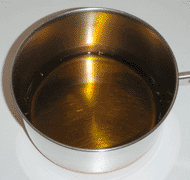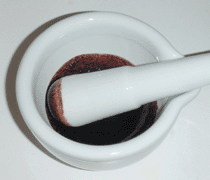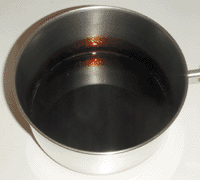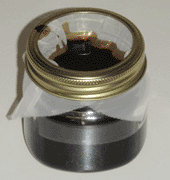
The previous boiled linseed oil, though potentially useful, had a number of problems that needed to be resolved. The first issue is the unreacted sediment; not only does this indicate that the incorporation of iron into the oil is inefficient, it also makes the drying characteristics of the oil unreliable, due to the lack of control over its iron content. The second issue is the low viscosity of the oil; although this makes it easier to apply, it also causes it to seep irregularly into the wood, extending the drying time (previous samples smelled of raw oil and were likely only dry on the surface) and creating dark patches in the finish. The third issue is the complexity of the heating schedule, which was purely incidental and likely unnecessary. This iteration of my boiled linseed oil project solves all three problems, and presents a straightforward path to making boiled linseed oil from scratch in the home workshop.
I began by weighing out 100 grams of raw linseed oil into a small (6 inch internal diameter) saucepan, covering the bottom in a thin layer to allow rapid oxidation. I then added a spoonful of this oil to a gram of ferric acetate flakes and ground the mixture using a mortar and pestle, adding it back to the bulk of the oil once it had become a uniform thin paste. The goal here was to maximize the surface area of the ferric acetate, enabling a faster and more thorough reaction with the oil. Heating was then accomplished with an electric hot plate; I simply brought the oil to its smoke point (roughly 240°C), then reduced the heat slightly until it stopped smoking (220°C). I then maintained this temperature for three hours, swirling the oil in the pan occasionally as a substitute for stirring. The ferric acetate dissolved entirely within the first half hour; the remainder of the time served primarily to thicken (polymerize) the oil. I then removed the oil from the heat, let it cool to room temperature, and filtered it into a small mason jar through a piece of 180-mesh printing screen, to remove some debris that the wind blew into the pan. These steps can all be seen below.




To test the drying time and finish characteristics of the oil, I painted a thin layer onto various types of wood and immediately buffed off any excess with a rag; the goal being to avoid uneven saturation of the wood grain, and to achieve a semi-reflective satin finish. Surprisingly, the surfaces of the test pieces were dry within 6 hours, and after spending the next afternoon in the sun they no longer had any smell, indicating complete drying within 20 hours. This was the case even on poplar, which is highly absorbent and tended to slow the drying of earlier oils. That particular test piece can be seen at the top of the page. Overall this oil appears to be a versatile, non-toxic wood finish with an acceptable drying time, and can be prepared with only raw linseed oil, vinegar, and steel wool. My intent is to use it in future projects, not only as a protective finish for handles and work surfaces, but also as a base for other types of coatings.